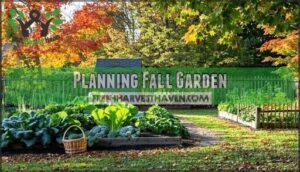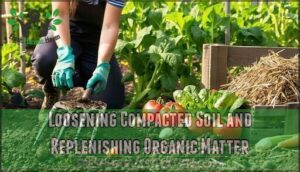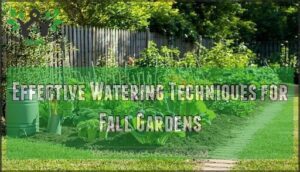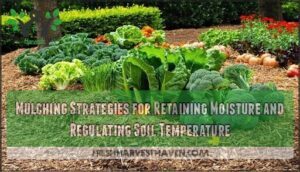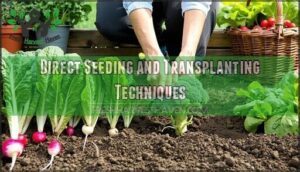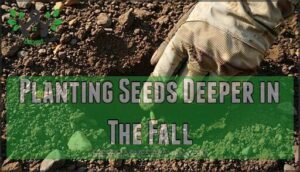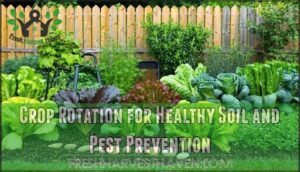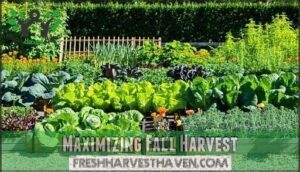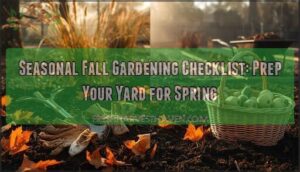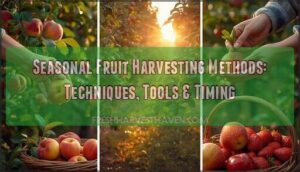This site is supported by our readers. We may earn a commission, at no cost to you, if you purchase through links.
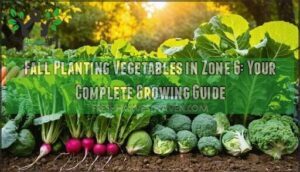
Focus on cold-hardy crops like kale, spinach, carrots, radishes, and Brussels sprouts that can handle cooler temperatures and shorter daylight hours.
Your first frost typically arrives between mid-October and early November, giving you roughly 10-12 weeks to establish strong plants.
Start cole crops like cabbage and broccoli indoors around mid-July, then transplant them outdoors in August.
Direct sow quick-growing vegetables like lettuce and turnips straight into the garden.
The cooler weather actually improves the flavor of many fall vegetables, making them sweeter and more tender than their spring counterparts.
Table Of Contents
- Key Takeaways
- Fall Planting Overview
- Planning Fall Garden
- Preparing Garden Soil
- Planting Fall Vegetables
- Maximizing Fall Harvest
- Frequently Asked Questions (FAQs)
- What to plant zone 6 in September?
- How late can I plant in zone 6?
- What fall vegetables can be planted now?
- How late can you plant in zone 6?
- What vegetables can you grow in Zone 6 in the winter?
- When should you start a fall garden?
- . Why Should You Start Seeds indoors?
- . Which Seeds Should You Start indoors?
- . When Should You Start Seeds indoors?
- . When Should You Transplant seedlings?
- Conclusion
Key Takeaways
- Start early in Zone 6 – Plant fall vegetables between late July and early August to give cool-season crops like kale, spinach, and carrots enough time to establish before your first frost hits in mid-October to early November.
- Choose cold-hardy varieties – Focus on frost-tolerant vegetables like Brussels sprouts, radishes, and leafy greens that actually taste sweeter after cold exposure and can handle Zone 6’s temperature drops.
- Use succession planting – Plant fast-growing crops like lettuce and radishes every 7-10 days through mid-September to ensure continuous harvests throughout the fall season.
- Extend your season with protection – Use cold frames, row covers, and mulch to create warmer microclimates that’ll keep your vegetables producing 6-8 weeks longer into winter.
Fall Planting Overview
Zone 6 gardeners can extend their growing season well into fall by selecting the right vegetables and timing their plantings carefully.
Smart Zone 6 gardeners unlock winter harvests through strategic fall planting timing.
With proper planning and cold-hardy varieties, you’ll enjoy fresh harvests even as temperatures drop and frost approaches, which allows for a longer period of fresh harvests.
Choosing Vegetables for Zone 6
Success in Zone 6 vegetable selection starts with choosing cool season crops that thrive in your climate.
Focus on hardy varieties like kale, spinach, and radishes that handle temperature drops gracefully.
Consider these proven crop choices for zone 6 gardening:
- Leafy greens – spinach and kale tolerate frost beautifully
- Root vegetables – carrots and beets develop sweeter flavors in cool soil
- Fast-maturing options – radishes and lettuce provide quick harvests
Smart fall planting vegetables require matching growth rates to your frost timeline.
Understanding the fall planting guide is essential for a successful harvest.
Selecting Fall-Harvested and Cold-Hardy Varieties
Once you’ve narrowed down your Zone 6 fall garden choices, you’ll want frost resistant varieties that actually improve with cooler weather.
Cold hardy vegetables like kale, Brussels sprouts, and spinach don’t just survive Zone 6’s November frost—they thrive, developing sweeter flavors after exposure to cold temperatures.
Fall crop selection should prioritize cool season crops with proven vegetable tolerance ratings.
These frost tolerant varieties handle Zone 6’s temperature swings better than their summer counterparts.
Smart seasonal planting means choosing cultivars specifically bred for zone 6 gardening success, ensuring your harvest continues well into autumn.
Top Vegetables for Zone 6 Selection
Throughout the growing season, you’ll want to focus on cool season crops that handle Zone 6’s changing temperatures with ease.
- Leafy greens like spinach and kale varieties thrive in cooler fall weather
- Root vegetables such as carrots and beets develop sweeter flavors in cool soil
- Brassicas including broccoli and cauliflower perform best when fall planting vegetables in autumn
- Hardy cool weather crops like turnips and radishes mature quickly before frost
- Garlic planted in late October provides next summer’s harvest
Planning Fall Garden
Successful fall gardening in Zone 6 starts with understanding your local frost patterns and working backward from that key November 1st date.
You’ll need to calculate planting times carefully, counting back the days to maturity listed on seed packets to guarantee your vegetables have enough time to grow before winter arrives.
Determining First Frost Dates for Your Region
Frost Dates in Zone 6 typically fall between September 30 and October 20, but your exact location matters.
Check local Weather Forecast data and Climate Zones maps for precise timing. Urban areas delay First Frost by several days due to heat islands.
Regional Planning requires monitoring NOAA records and extension services. Your Fall Planting success depends on understanding these local variations within Zone 6 rather than relying solely on general Frost Tolerance guidelines.
Calculating Seeding Dates for Optimal Growth
Once you’ve pinpointed your frost dates, calculating accurate seeding dates becomes straightforward math. Count backward from November 1st using each crop’s maturity rates plus a 10-day buffer for Zone 6’s unpredictable weather.
Here’s your fall planting schedule formula:
- Check seed packets for growth periods and add 10-14 extra days for slower fall conditions
- Factor in 7-14 days for germination before counting maturity time
- Use succession planting schedules every 10 days for continuous harvests
Cool-season crops like spinach need 50-60 days before frost, while frost tolerance varies by variety. This backward-counting method guarantees your zone 6 vegetables mature before winter arrives.
Establishing Fall Vegetables Before Cold Weather
With fall planting vegetables in zone 6, you’ll need solid frost protection strategies before cold weather arrives.
Start your cool season crops early enough to establish strong root systems, then apply mulch and row covers when temperatures drop.
Here’s your action plan:
Frost Protection
Preparing Garden Soil
Your fall garden needs proper soil preparation to support healthy vegetable growth through cooler temperatures.
Good soil preparation creates the foundation for thriving fall vegetables in cooler weather.
Start by loosening compacted soil and adding organic matter like compost to create the ideal growing environment for your cold-hardy crops.
Loosening Compacted Soil and Replenishing Organic Matter
Your garden’s foundation determines fall success, so break up compacted soil with a pitchfork or tiller for proper soil aeration. Mix in compost amendments like aged manure to boost organic matter and nutrient cycling.
Here’s your soil preparation checklist:
- Test soil pH before adding amendments for ideal growing conditions
- Apply organic mulch around plants to retain moisture and regulate temperature
- Brew compost tea weekly to feed beneficial microorganisms naturally
- Remove debris completely before incorporating any soil improvements
Using effective compost tea methods can enhance soil health. This fall gardening approach guarantees your Zone 6 vegetables thrive in nutrient-rich, well-structured soil.
Effective Watering Techniques for Fall Gardens
After preparing your soil with organic matter, proper watering techniques facilitate healthy fall planting success in zone 6.
Drip irrigation delivers water efficiently, reducing evaporation by 25-35% compared to overhead sprinklers. Monitor soil moisture at 2-4 inch depths using your finger or probe.
Water deeply once weekly, reaching 4-6 inches down for strong root development. Early morning watering prevents fungal diseases while maximizing water conservation.
Rainwater harvesting supplements irrigation needs effectively. Proper watering techniques combined with consistent moisture retention create ideal growing conditions for your vegetables.
Understanding the fall garden basics is vital for a thriving garden in any climate.
Mulching Strategies for Retaining Moisture and Regulating Soil Temperature
Smart gardeners consistently rely on organic mulch for successful fall planting in Zone 6. Apply 2-3 inches of straw or shredded leaves around your cold hardy vegetables, keeping stems clear for proper soil aeration.
Here’s why mulching transforms your fall garden:
- Moisture retention reduces watering needs by 50%
- Soil temperature stays 5-10°F warmer overnight
- Root systems develop stronger, deeper networks
- Weeds can’t compete with your vegetables
- Mulch depth creates the perfect insulation barrier
This simple strategy protects your investment while boosting yields. Using the right organic mulch types is vital for achieving the best results.
Planting Fall Vegetables
Once you’ve prepared your soil, you’ll need to master the right planting techniques to guarantee your fall vegetables thrive in Zone 6’s cooling conditions.
The key is understanding when to direct seed versus transplant, adjusting your planting depth for fall conditions, and rotating crops to maintain soil health.
Direct Seeding and Transplanting Techniques
With your soil ready, you’ll need to master direct seeding and transplanting techniques for Zone 6 fall planting vegetables.
Most cool-season crops like radishes and spinach thrive when directly seeded into prepared garden beds.
For transplants such as kale or broccoli, proper hardening off prevents shock during the move.
Consider your garden layout carefully—direct seeding works best for fast-growing crops, while transplant tips include gradual exposure to outdoor conditions before final planting.
Choosing the right Fall Seeds is vital for a successful harvest.
Planting Seeds Deeper in The Fall
When planting seeds in fall, you’ll want to go deeper than spring sowing. Cooler soil temperatures slow germination, but deeper planting improves root development and moisture retention while protecting against frost heaving that can disturb shallow seeds.
Key adjustments for fall seed depth:
- Add an extra half-inch to your normal planting depth for better frost protection
- Use loose, well-draining soil to prevent waterlogging around deeper seeds
- Cover gently but thoroughly to trap soil warmth and maintain consistent moisture
This deeper planting technique helps your fall vegetables establish stronger root systems before winter arrives. Understanding fall garden planning is essential for a successful harvest.
Crop Rotation for Healthy Soil and Pest Prevention
Beyond proper seeding depth, crop rotation transforms your zone 6 fall planting vegetables into a thriving ecosystem.
This organic methods approach disrupts pest control cycles while boosting soil health naturally.
Your crop planning strategy should cycle plant families through different beds yearly, preventing pest prevention issues.
Follow heavy feeders with legumes to restore nitrogen levels.
Practice garden sanitation by removing debris between rotations.
This soil preparation technique reduces disease pressure by 75% while improving yields, making your fall garden more resilient and productive.
Maximizing Fall Harvest
You can maximize your fall harvest through strategic succession planting and smart season extension techniques.
These methods will keep fresh vegetables flowing from your garden well into winter, making the most of Zone 6’s extended growing season.
Succession Planting for Extended Harvest Times
Maximize your fall harvest through staggered sowing every 7-10 days until mid-September. This succession planting technique guarantees continuous production as earlier crops finish.
Focus on quick-maturing cool-season crops like lettuce and radishes for ideal harvest timing in zone 6.
Seed selection and soil preparation between plantings maintain productivity:
- Plant lettuce varieties every week through September
- Sow radishes every 10 days for consistent harvests
- Replace finished crops immediately with new plantings
- Enrich soil with compost between succession rounds
- Choose fast-maturing varieties for reliable fall planting success
Utilizing Season Extension Devices for Longer Growing Seasons
The secret to extending your Zone 6 fall harvest lies in simple protective structures that create warmer microclimates around your crops.
Cold frames boost soil temperatures by 5-10°F, while row covers and frost blankets provide essential protection during unexpected cold snaps.
These season extension tools transform your garden into a productive powerhouse that keeps delivering fresh vegetables well into winter.
- Cold frames act like mini-greenhouses, perfect for protecting leafy greens and maintaining soil warmth through thermal mass
- Row covers and frost blankets offer 2-8°F of frost protection while allowing sunlight and water to reach your plants
- Hoop houses and greenhouses create controlled environments that can extend your growing season by 6-8 weeks in fall planting scenarios
By using techniques for fall season extension, gardeners can enjoy a longer harvest period and increased crop yields.
Harvesting and Storing Fall Vegetables for Later Use
Your fall harvest timing determines winter storage success. Root vegetables like carrots and beets develop peak flavor after first frost, while leafy greens require harvesting before sustained freezing temperatures arrive.
| Storage Method | Best Vegetables |
|---|---|
| Root Cellars | Carrots, beets, turnips |
| Freezing Methods | Spinach, kale, broccoli |
| Dehydration Techniques | Tomatoes, peppers, herbs |
Storage Solutions vary by crop type. Cold-hardy vegetables like Brussels sprouts handle light frost well, but canning tips suggest processing tender crops immediately. Proper storage techniques guarantee your freezing vegetables maintain quality through winter months.
Frequently Asked Questions (FAQs)
What to plant zone 6 in September?
In Zone 6, September’s your prime window for planting cool-season vegetables that’ll thrive in cooler temperatures. Plant lettuce, spinach, kale, radishes, and turnips now for harvest before frost hits.
How late can I plant in zone 6?
Like a marathon runner eyeing the finish line, you can plant hardy vegetables through mid-to-late October in Zone
Cold-tolerant crops like spinach and garlic thrive when sown before winter’s grip tightens.
What fall vegetables can be planted now?
Right now, you can plant spinach, kale, radishes, and lettuce for quick harvests. These cold-hardy vegetables handle frost well and mature within 4-8 weeks before hard freeze arrives.
How late can you plant in zone 6?
You’ve got until mid-to-late October for cold-hardy crops like spinach and garlic. Most vegetables need planting by late September to mature before November’s first frost hits.
What vegetables can you grow in Zone 6 in the winter?
You can grow hardy vegetables like kale, spinach, and Brussels sprouts in Zone 6 winters. These frost-tolerant crops survive temperatures down to 25-28°F and actually taste better after cold exposure.
When should you start a fall garden?
Start your fall garden in Zone 6 between late July and early September, depending on your chosen vegetables.
Plant fast-maturing crops like radishes by mid-September, while slow-growing brassicas need an August start.
. Why Should You Start Seeds indoors?
You’ll start cabbage family vegetables indoors because they grow slowly in cold temperatures and need summer warmth to establish strong roots before transplanting outdoors ahead of frost.
. Which Seeds Should You Start indoors?
Like choosing the right tool for each job, starting seeds indoors requires selecting crops that need extra time or protection.
Start cabbage family vegetables (Brussels sprouts, cauliflower, broccoli) indoors since they’re slow-growing in cold temperatures.
. When Should You Start Seeds indoors?
Looking at fall planting timelines, cabbage family vegetables need indoor starting about 10-12 weeks before your first expected frost.
For Zone 6’s November 1st frost date, you’ll want to start these seeds indoors around mid-August for ideal transplant timing.
. When Should You Transplant seedlings?
Transplant your seedlings when they’re 4-6 weeks old with strong roots. Move them outdoors before the first frost to capture remaining summer warmth for establishment.
Conclusion
Success doesn’t happen overnight regarding fall planting vegetables in Zone 6, but with proper timing and preparation, you’ll enjoy fresh harvests well into winter.
Your cooler autumn temperatures naturally enhance flavors, making vegetables sweeter and more tender than spring crops.
Remember to start cold-hardy varieties by early August, protect plants from unexpected frosts, and use succession planting for continuous harvests throughout the season.

